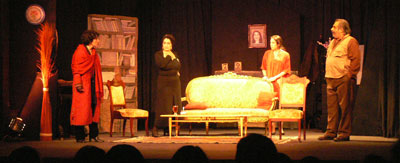
In memory of Kazem Ashtari will be performed at Oaks Theater in Berkeley, California, for three more nights, March 14,15,16.
Backstage, after seeing “In memory of Kazem Ashtari,” I told actress Bella Warda that I thought her character, the resilient Mahin Ashtari is in very good hands. If you haven’t been backstage after a play, prepare for a jolting experience. There is strong magic in speaking to someone–still in costume and sweating from the ordeal–who has just returned from the story world. This is something film can never do.
As I waited to congratulate actress Sepideh Khosrowjah, she was still the ambitious yet easily dominated character, Shafagh Gooya. The fact that as playwright Khosrowjah created Shafagh and all the other characters in the comedy belonged to the reality she was just coming back to.
Director Hamid Ehya was thoughtful, absently submitting to our praise. What worked, what didn’t work with the audience? I bet he wishes Mahin’s wisecrack to Shafagh were true.
Shafagh: But do you even know how to direct?
Mahin: Directing doesn’t need any knowing how!
Funny line! Ehya’s task was far messier than “simply” interpreting the work. For example, Warda has strong stage tactics. Like a good chess player she goes after the center and holds it, inclining the other characters to speak towards center stage instead of out to the audience. Remedying this without diminishing Warda’s presence takes careful problem solving.
Here’s another example, this time in set design. There is a door-answering phone where Mahin’s daughter, Atefeh, gives us the first “oh shit” moment of the play. Someone’s at the door she did not expect. This event begins the story’s climb; yet its comic impact is threatened by a small stage that forces the phone in an awkward out-of-the-action place. The young actress Shadi Yousefian has funny body and face language when the sky falls down, and stage limitations constrained one of her good moments. But to borrow from Donald Rusmsfeld, you direct with the stage you’ve got. Budget, time, and resource juggling makes the director as much mathematician, as artist. When you see the play, watch for the limitations to appreciate the director.
Putting on his artist hat, Ehya has introduced a clever sideshow that takes place before the curtains open and during scene changes. In this slide show appear the play’s characters in their earlier days. We see film director Kazem Ashtari pretending to be chummy with Iranian film icons and Mohammad-ali Fardin. There he was stretching to match heights with the great filmmaker Bahram Beizai, proudly displaying Atefeh when she was a baby, and smiling next to his stunning young wife, Mahin. There are also pictures of his abysmally designed B-movie film posters, graced only by the face of the beautiful actress Shafagh Gooya. These images are intermingled with unintentionally hilarious condolence cards from a film industry that rightly did not take Ashtari seriously while he was still alive.
These preludes add greatly to the emotional and comedic impact of the play; they help especially with act one which is often the thinnest act in any play.
In act two the plot heats up. Mahin Ashtari has published the love letters her husband had sent to Shafagh Gooya. Mahin has prefaced the collection with, “Dedicated to my wife, Mahin, my only love in life.” Shafagh storms into Mahin’s house, pissed about the blatant lie. But Mahin, who over the years has transmuted her pain into wisdom, makes a devious proposition to Shafhagh. A proposition that eventually makes Kazem Ashtari deader than he was before.
After the show I saw Kazem Ashtari sucking up to Hamid Ehya. I wanted to warn Ehya about what a scoundrel Ahstari is, never mind that Ehya was really consulting with Mansour Taeed, the wonderful actor and promoter of Iranian culture. Backstage magic takes a long time to wear off. Try it though!






